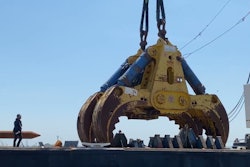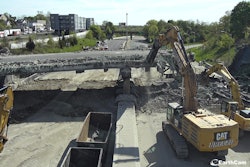Editor's Note: This story was updated May 20, 2024, with news that refloating and moving the cargo ship Dali began May 20.
The day after debris from the collapsed Key Bridge in Baltimore was exploded to free the cargo ship underneath the wreckage, the National Transportation Safety Board released its preliminary report of the incident.
To watch the precision blast of the section of the bridge’s remains on the Dali, check out the video clips above shot by U.S. Coast Guard Petty Officer 3rd Class Jackson Henderson and Christopher Rosario, U.S. Army Corps of Engineers.
The explosion May 13 to remove debris from the ship’s deck means the Dali and its 22 crew members who have remained on the ship can be floated out of the Fort McHenry Channel, another milestone in the cleanup to reopen the port by the end of May.
On May 20, the ship was refloated and being moved back to port to clear the channel, according to the U.S. Army Corps of Engineers, Baltimore District.
 USACE, Baltimore District
USACE, Baltimore District
NTSB Findings
The NTSB report released May 14 confirmed the 947-foot-long Dali lost electrical power and propulsion March 26 before striking the Francis Scott Key Bridge, but revealed that it had lost power on several occasions, including the day before the crash.
On March 25, the Dali experienced a blackout during in-port maintenance, according to the report. A crew member also mistakenly closed an inline engine exhaust damper, causing the engine to stall. A second blackout occurred when crew members manually closed two breakers. That led an emergency generator to start, but it didn’t have enough fuel pressure and caused another breaker trip and power outage. So the crew switched to two different breakers.
Then at about 1:25 a.m. March 26, when the Dali was .6 miles from the bridge, the two electrical breakers the crew had switched to at port tripped, causing another blackout. Power to the main engine cooling water pumps also went out, leading the main engine to automatically shut down. This caused its propellor to stop. All three steering pumps also went out.
The crew closed the two breakers and started two generators that restored power. The crew then called for tug assist at about 1:26 a.m. The tug was on the way but couldn’t reach it in time.
At 1:27 a.m., the crew began to drop the anchor.
When it was about .2 miles from the bridge, the ship’s power failed again, causing a total loss of electrical power. A generator kicked in and restored power.
The main engine, however, remained shut down, so there was no propulsion to help steer the ship. A crew member sent out a warning on marine radio.
The crew regained engine power just before it hit the bridge, but the ship did not regain propulsion.
 The Dali’s route March 26 between the first blackout and the Dali striking pier 17 on the Key Bridge. The location and approximate size of two of the bridge’s pier protective “dolphins” are labeled in the lower right of the above graphic.NTSB
The Dali’s route March 26 between the first blackout and the Dali striking pier 17 on the Key Bridge. The location and approximate size of two of the bridge’s pier protective “dolphins” are labeled in the lower right of the above graphic.NTSB
A road maintenance inspector had been walking the length of the bridge when the ship struck. He ran to the nearest surviving span before the rest of the bridge collapsed.
The seven workers on the bridge filling potholes were all inside vehicles that fell into the Patapsco River. One worker escaped his truck that had fallen into the river and was rescued by boat about 15 minutes later. The six other bodies have since been recovered, with the final body recovered May 7.
The ship’s crew tested negative for drug and alcohol use after the crash. The bridge had last been inspected May 2023 and was rated in “satisfactory condition,” according to the NTSB report.
The NTSB plans to continue examining the Dali’s power and fuel systems and is working with agencies to assess other bridges and whether their pier protection needs to be improved. It noted that the new report is preliminary and does not lay out a probable cause. That final report will not be available until the agency concludes its investigation.
The Blast
After the May 13 blast, the U.S. Army Corps of Engineers Baltimore District plans to float the ship back to port over the next couple of days on a high tide. The crew on the ship sheltered in place during the precision blasting and will return to port with the ship.
Crews strategically placed multiple small explosives in incisions in the debris.
After that, the corps will focus on removing the rest of the debris from the 700-foot-wide, 50-foot-deep channel. It estimated that 50,000 tons of debris fell into the river, blocking the channel.
About 6,000 tons have been removed as of May 12. Alternative temporary channels have been opened for limited traffic. Full reopening is still planned by May 31.
The Dali has been refloated and was heading back of a port terminal at high tide, which began at 5:24 a.m., according to the corps.















